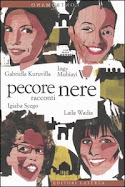L’Europa difende Cécile Kyenge dagli italiani
di Andrea Mollica - 24/09/2013 - Per la prima volta nella storia i rappresentanti di 16 stati membri dell'UE si schierano con una ministra contro il razzismo
Dopo gli attacchi più o meno razzisti dei mesi scorsi Cécile Kyenge ha ottenuto la solidarietà dell’Europa. Ben 17 paesi dell’UE si sono trovati a Roma per dare sostegno alla ministra dell’Integrazione, paragonata ad un orango-tango da Calderoli e ripetutamente oggetto di attacchi rivolti contro il suo colore della pelle. Una novità nella storia dell’UE, che rafforza l’impegno della Kyenge, in realtà piuttosto isolata nel governo Letta.
UE CON LA KYENGE - L’Unione europea quasi sempre divisa ritrova un’unità nella difesa di Cécile Kyenge. L’incontro a Roma tra la Kyenge e altri 16 ministri o rappresenti di stati membri dell’Ue appare come una piena solidarietà alla responsabile del dicastero dell’Integrazione, che ha ricevuto una lunga serie di attacchi razzisti, a partire dal paragone con un orango-tango pronunciato da Roberto Calderoli. 17 rappresentanti di altrettanti Stati Ue si sono riuniti ed hanno condiviso una Dichiarazione contro il razzismo. L’iniziativa è partita dal vicepremier e ministro dell’Interno del Belgio Joelle Milquet, esponente di un partito centrista vallone, che ha mobilitato i colleghi a difesa di Cecile Kyenge, vittima di numerosi attacchi di stampo razzista sin dal momento della sua nomina.
EUROPA DELLE DIVERSITÀ - I responsabili di Belgio, Lituania, Lettonia, Irlanda, Svezia, Francia, Grecia, Croazia, Polonia, Portogallo, Gran Bretagna, Romania, Bulgaria, Cipro e Malta, insieme al ministro Kyenge, hanno proposto agli Stati membri e alla Commissione europea di lanciare un Patto settennale, dal 2014 al 2020, per una “Europa delle diversità” e per contrastare tutte le forme di razzismo, xenofobia e discriminazione. ”I leader politici – si afferma – devono essere modelli di unità, di accettazione della diversità e di tolleranza, non attori di divisioni e intolleranza”. Nella Dichiarazione di Roma, il documento condiviso nel Meeting lanciato dalla Milquet e dalla Kyenhe, sono fermamente condannati «i programmi politici e le organizzazioni basate sul razzismo, la xenofobia e le teorie di superiorità razziale». La Dichiarazione chiede inoltre ai paesi membri dell’UE l’adozione di «strumenti legali per l’effettiva prevenzione, repressione ed eliminazione del razzismo, della discriminazione razziale, della xenofobia e della discriminazione di genere».
LOTTA AL RAZZISMO - La vice primo ministro del Belgio, Joelle Milquet, ha ribadito l’importanza della presa di posizione in supporto di Cécile Kyenge. «Dobbiamo reagire alle manifestazioni di razzismo», ha rimarcato la Milquet, che ha definito inaccettabili gli attacchi subiti dalla collega italiana. «Era importante reagire e agire, in tutta l’Europa ci sono movimenti politici che predicano il rifiuto dell’altro, dello straniero, occorre mobilitarsi per riaffermare i valori della tolleranza». La ministra italiana ha invece precisato che la solidarietà europea nei suoi riguardi non rappresenti un problema legato solo alla sua persona. « Questo problema non riguarda solo me, sono atteggiamenti che stanno riaffiorando ovunque. Bisogna cercare di reagire non solo in quanto sostegno alla mia persona, ma cercando di riaffermare i valori dell’Europa. Il nostro messaggio oggi è quello che vogliamo riaffermare la cultura della solidarietà, dei nostri valori all’interno dell’Ue, e dobbiamo farlo anche in vista delle elezioni europee».
MESI DI INSULTI - La nomina di Cécile Kyenge al ministero dell’Integrazione ha da subito suscitato forti polemiche. Non solo il colore della pelle, ma anche le posizioni della ministra Kyenge hanno creato un movimento di opposizione che, per quanto apparentemente minoritario, è stato molto feroce nei suoi attacchi. Dopo essersi schierata pubblicamente in favore dello ius soli, l’esponente del PD ha subito continue provocazioni da parte della Lega Nord, che per alcune settimane l’ha praticamente assediata in ogni iniziativa svolta sul territorio. Allo stesso tempo sono partiti pesanti attacchi personali, culminati nel paragone con un orango-tango declamato, tra la delizia della folla, dal leghista, ed ex ministro, Roberto Calderoli. Forza Nuova, partito neofascista, è stata ancora più aggressiva, lanciando banane sul palco delle feste dove parlava la Kyenge, e depositando manichini che rappresentavano immigrati morti contro lo ius soli. Una serie di attacchi violenti che hanno provocato una presa di posizione dell’Ue piuttosto inusuale.






























